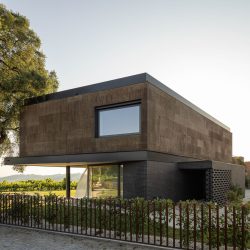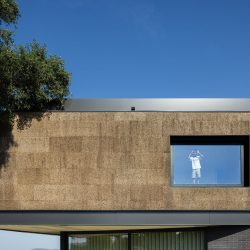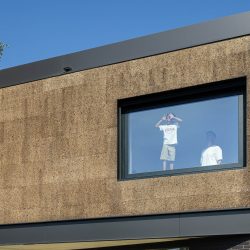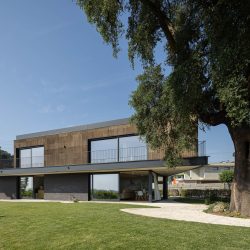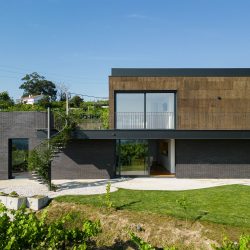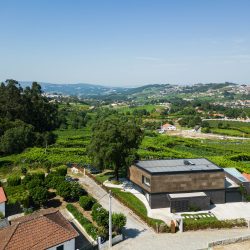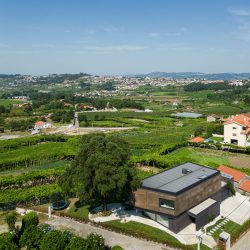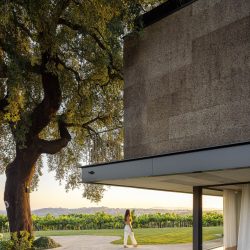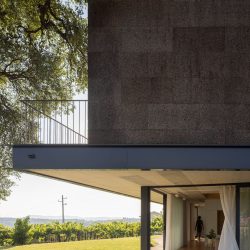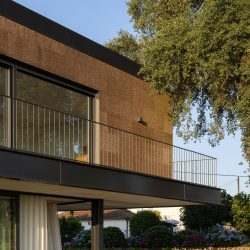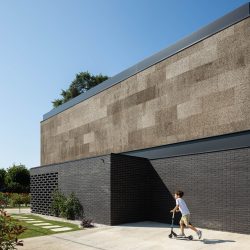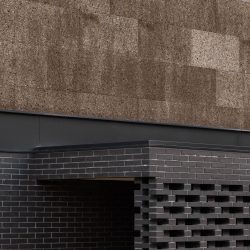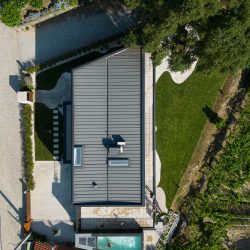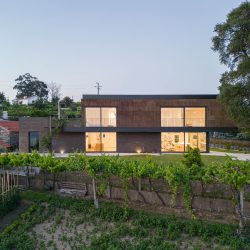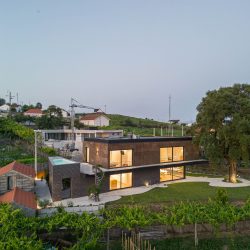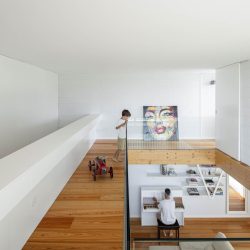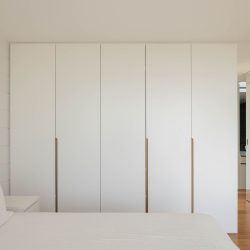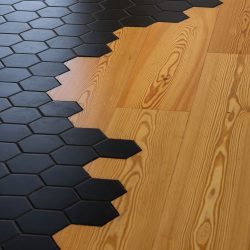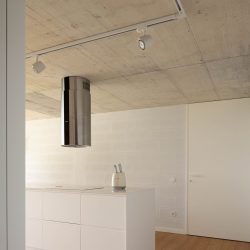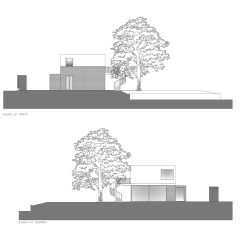
Skemba – Arquitectura|Engenharia . photos: © Ivo Tavares Studio
The project in question is intended for a single-family home that revolves around a remarkable element of the land, a century-old Cork Oak tree. We can start this description by alluding to the project’s title: “The House of the Cork Oak” and not “The Cork Oak of the House.” This is because the said tree emerges as the main and prominent element throughout the intervention.
The land, approximately 730 square meters, is located in a small rural cluster in the parish of Figueiró – Amarante. The access road is narrow, with constructions like houses, fencing/support walls, and/or small buildings adjacent to it.
Starting with the large Cork Oak, valuing it and promoting harmony with the built volume, the proposal respects the setback from the road and neighboring constructions with several decades of existence, the path of servitude to the west, and the boundary of the national agricultural reserve to the south. The solar exposure and the landscape also played a crucial role in the design.
From the elevation facing the street, the house closes itself off to the road, with only the entrance volume standing out, while opening to the south to embrace the landscape and the garden space. The upper volume (made of cork) extends outward relative to the ground floor (made of exposed brick), coming closer to the majestic Cork Oak, respecting its canopy, and creating a covered area that serves as an extension of the social zone.
On the opposite side, next to the existing construction, the ground floor volume moves away and gains height, creating a small pool that serves the terrace and balcony of the bedrooms.
Internally, the house was designed for a family of two adults and two children. Its functionality is straightforward, with clearly defined spaces. On the ground floor, there is only a central volume around which one can circulate between the entrance hall, living room, and kitchen. This volume includes furniture to support the living room and kitchen, a pantry, a bathroom, and the staircase leading to the upper floor with the bedrooms.
The desired fluidity and communication between spaces are realized through the double-height space in the living room area, where one can circulate to the three bedrooms.
The house aims to coexist harmoniously with the grand Cork Oak, always respecting its presence and giving it due prominence and importance without compromising the function and enjoyment of the surrounding outdoor space.
_
Nome do Projeto . Project name: Casa do Sobreiro
Atelier de Arquitectura . Architecture Office: Skemba – Arquitectura|Engenharia, Lda.
Arquiteto responsável . Main Architect: Rui Faria
Localização . Location: Figueiró Santiago – Amarante
Ano de conclusão da obra . Year of conclusion : 2021
Área total construída (m2) . Total area: 318,08 m2
Construtora . Builder
Fiscalização . inspection:
Engenharia . Engineering:
Paisagismo . Landscape:
Projeto Luminotécnico . Light Design:
Acústica . Acoustic Design:
Hidráulica . Fluids Engineering :
Térmica . Thermal Engineering:
Identidade Visual . Visual identity:
Ilustrações . illustrations:
Decoração de interiores . Interior Design:
Fotógrafo . Architectural photographer: Ivo Tavares Studio
O projeto em causa destina-se a uma moradia unifamiliar que parte de um elemento marcante do terreno, um Sobreiro centenário. E podemos iniciar esta descrição fazendo uma alusão ao título do projeto: “A Casa do Sobreiro” e não “O Sobreiro da Casa”. Isto porque a dita árvore surge como o elemento principal e em destaque em toda a intervenção. O terreno em causa, com cerca de 730 m2 situa-se num pequeno aglomerado rural na freguesia de Figueiró – Amarante. A rua de acesso de dimensões reduzidas e onde as construções que “colam” à mesma, sejam moradias, muros de vedação/suporte e/ou anexos. Partindo sempre com o Sobreiro de grandes dimensões, valorizando o mesmo, promovendo a comunhão com o volume edificado, a proposta desenvolveu-se respeitando o afastamento ao arruamento e aos anexos vizinhos com várias décadas de existência, ao caminho de servidão a poente, e à faixa limite da reserva agrícola nacional a sul. A exposição solar e a paisagem completam os pressupostos iniciais. Do Alçado voltado à rua fecha-se para a mesma, destacando-se apenas o volume de marcação da entrada, abrindo a moradia a Sul para a paisagem e para o espaço ajardinado. O corpo superior (em cortiça) projeta-se relativamente ao rés do chão (em tijolo face à vista) aproximando-se do grande sobreiro, respeitando a copa do mesmo e criando uma zona coberta que faz o prolongamento da zona social. Do lado oposto, junto ao anexo existente, o remate foi feito com o volume do rés do chão que se afasta e ganha altura criando uma pequena piscina que serve o terraço e varanda dos quartos. Interiormente, a casa foi pensada para uma família de dois adultos e duas crianças, o funcionamento da casa é muito simples, sem grandes obstáculos e com os espaços claramente definidos. No rés do chão existe apenas um volume central à volta do qual se circula entre hall de entrada, sala e cozinha. Volume esse que inclui o mobiliário de apoio à sala, à cozinha, despensa, instalação sanitária e escada de acesso ao piso dos quartos. A fluidez que se pretendia na casa e comunicação entre os diversos espaços formaliza-se através do duplo pé direito na zona da sala de estar, à volta do qual se circula para os três quartos. A casa pretende coexistir com o grande sobreiro e respeitar sempre a sua presença, dando-lhe o devido destaque e relevância sem prejudicar a função e o usufruto do espaço exterior envolvente.

